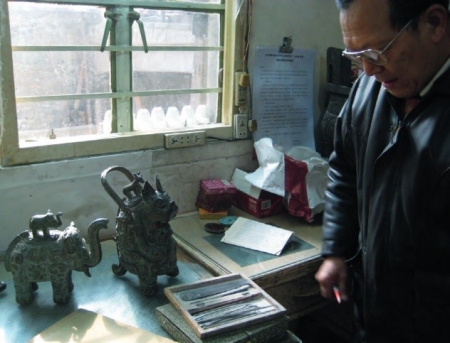My study focuses on a group of young professionals who built the Shanghai Museum collection. These men and women managed acquisition campaigns for the PRC’s State Administration of Cultural Heritage. They seized antiquities from individuals under political scrutiny. They also requisitioned antiquities from newly nationalized work units, such as local art dealerships, archaeological institutions, and privately owned museums. Employees at Chinese museums began systematically seizing art in the early 1950s and continued the practice through the initiation of the Open Door Policy in 1978. During the height of the Cultural Revolution (1966–1969), these young professionals requisitioned more than 106,000 antiquities from private residences, expanding the Shanghai Museum’s art collections by more than 70 percent. They also managed the sale of seized art overseas, as part of the PRC’s ongoing campaign to profit from the international art market. The PRC’s enterprise of appropriation also redefined Chinese art. New export regulations categorized objects created after 1795, the last year of the Manchu emperor Qianlong’s reign, as commodities: handicrafts available for both domestic and overseas consumption. Art objects made before 1795 could no longer be exported without state-level intervention. Museum employees enforced these regulations both in the art market and through their own process of appropriation, making 1795 an international demarcation of Chinese cultural heritage. This policy affirmed what cultural arbiters in China and overseas had assumed: that the end of Qianlong’s reign also marked the end of quality art production in China. The regulations remained unchanged until the late 1970s, when the astronomical rise in the prices of Chinese art, as well as the growth of overseas Chinese art collections, prompted changes to the 1795 rule.
This study further identifies Shanghai Museum employees as the chief agents of salvage archaeology in East China, a program that changed the profile of bronze relics in museums across the nation. From 1949 onward, metal refineries and waste repositories were subjected to regular inspections for objects of value. Museum employees retrieved ancient bronzes from smelting pits throughout the Shanghai metropolitan area, collecting so many bronze coins, mirrors, and vessels that they recorded salvaged items by the ton. The bounty from the salvage program led to the establishment of entire bronze collections. In 1955 alone, the Shanghai Museum’s salvage archaeologists sent 163 museum-quality bronzes to the Anhui Provincial Museum, 175 to the National Palace Museum in Beijing, and 32 to the Northwestern History Museum in Shaanxi province. Bronzes of lesser quality were distributed to local hotels and restaurants as showpieces. As a result, ancient bronzes gained a more substantial and identifiable presence in the PRC, while the Shanghai Museum acquired a reputation as the institution that had put bronzes on the Chinese art-historical map.
My year in residence at CASVA allowed me to rework my dissertation as a book manuscript by revising the chapters that address these issues and completing a final chapter and conclusion. These later sections examine the development of the PRC’s controversial art restitution policy. In 1972 the Politburo passed a directive that allowed Chinese citizens to demand that museums recompense them for art appropriated since the 1950s. Options for such restitutions included physical return, cash compensation, and the replacement of missing appropriations with objects of similar value. I discuss the complex and in many
Members' Research Report Archive
Seizing Civilization: Antiquities in Shanghai's Custody, 1949–1996
Di Yin Lu [Harvard University]
Andrew W. Mellon Fellow, 2010–2012
In 1949 the newly established People’s Republic of China (PRC) initiated an ambitious enterprise of art appropriation that converted all antiquities in the country from private to public property. This program, which has continued uninterrupted over the past six decades, reshaped China’s art markets and created the largest public collections of Chinese art in the world. Using the Shanghai Museum as a lens, my research reveals how this program justified a nationwide seizure of art and cast ethnic minority artifacts and craft objects, in addition to ceramics, paintings, and bronzes, as the relics of five thousand years of Chinese civilization. I argue that the PRC’s enterprise of appropriation altered the concept of Chinese cultural heritage and established a set of institutional processes that selectively erased the provenance of objects in Chinese museums.

Gu Youchu of the Shanghai Museum with reproduction bronzes based on those retrieved through salvage archaeology (lower left), as well as the tools that museum employees invented to care for bronze relics (center), Shanghai, China. Author photograph